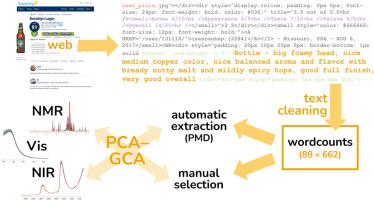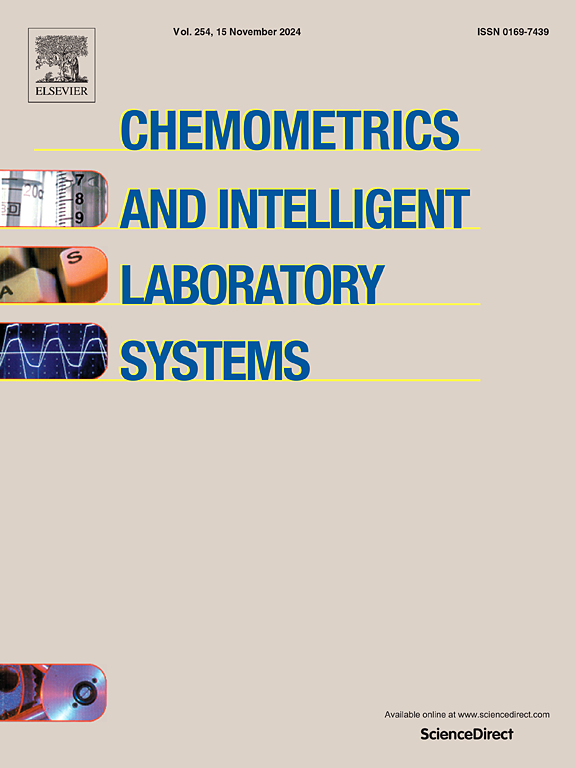比尔的语言学和化学:开启新的研究视角的调查
IF 3.8
2区 化学
Q2 AUTOMATION & CONTROL SYSTEMS
Chemometrics and Intelligent Laboratory Systems
Pub Date : 2025-08-30
DOI:10.1016/j.chemolab.2025.105521
引用次数: 0
摘要
在过去的二十年里,人们对食品生产和消费的兴趣逐渐增长,同时,在微型啤酒厂和家庭酿造的推动下,精酿啤酒蓬勃发展。啤酒是一种复杂的混合物——从碳水化合物到蛋白质和乙醇——由配方、原料和生产过程决定。不太明显的是,人类的舌头与口腔和鼻子协同作用,充当了一个强大的传感器阵列。品尝体验可以被视为“分析会议”,大脑处理的感官信号不仅决定了啤酒是否被欣赏,还决定了感知到的味道和风味。在我们的研究中,我们调查了啤酒的“客观”化学特征与用户评论的“主观”感官描述之间的联系。我们使用近红外(NIR),可见光和核磁共振(NMR)光谱分析了88种啤酒,将它们与通过自然语言处理(NLP)工具处理的文本评论配对,并通过单词袋方法转换为数字数据。主成分分析-广义典型分析(PCA-GCA)揭示了化学信号与“啤酒花”、“棕色”和“酒”等话题之间的相关性。核磁共振数据显示出最强的相关性,特别是与啤酒花相关的术语,而可见光谱与颜色描述符有关。自动主题提取通常与人工术语选择相当,这表明可扩展研究的潜力。尽管存在数据集大小和啤酒种类等限制,但这种方法显示出将化学成分与感官知觉相结合的前景,并可用于产品开发和更广泛的食品分析。一种新颖的方法通过化学计量学将文本语料库与分析数据相结合,将语言复杂性与工具响应联系起来。结果显示了很强的相关性,如核磁共振信号与啤酒花相关的术语和可见光谱与啤酒的颜色。这种以前未被探索的联系为设计适合消费者偏好的食品打开了大门。该方法广泛适用于从食品科学到医学诊断或将专家意见与事实数据结合起来。本文章由计算机程序翻译,如有差异,请以英文原文为准。

Beer's linguistics and chemistry: an investigation opening new research perspectives
In the last two decades, interest in food production and consumption has progressively grown, alongside the booming popularity of craft beer, fueled by micro-breweries and home brewing. Beer is a complex mixture of compounds — from carbohydrates to proteins and ethanol — shaped by the recipe, ingredients, and production process. Less obvious is that the human tongue, in synergy with the oral cavity and nose, acts as a powerful sensor array. Tasting experiences can be viewed as “analytical sessions”, where sensory signals processed by the brain determine not only if the beer is appreciated but also which tastes and flavours are perceived.
In our study, we investigated the connection between the “objective” chemical profile of beer and the “subjective” sensory descriptions from user reviews. We analysed 88 beers using near-infrared (NIR), visible, and nuclear magnetic resonance (NMR) spectroscopy, pairing them with text reviews processed through natural language processing (NLP) tools and converted into numerical data via a bag-of-words approach. Principal Component Analysis-Generalized Canonical Analysis (PCA-GCA) revealed correlations between chemical signals and topics like “hops,” “brown colour,” and “booze”. NMR data showed the strongest correlations, especially for hops-related terms, while visible spectra linked to colour descriptors. Automated topic extraction often performed comparably to manual term selection, suggesting potential for scalable studies. Despite limitations like dataset size and beer variety, this approach shows promise for aligning chemical composition with sensory perception, with applications for product development and broader food analysis.
A novel approach integrates text corpora with analytical data through chemometrics, linking language complexity to instrumental responses. Results showed strong correlations, like NMR signals with hops-related terms and visible spectra with beer colour. This previously unexplored connection opens the door to designing food products tailored to consumer preferences. The approach is broadly applicable, from food science to medical diagnosis or aligning expert opinions with factual data.
求助全文
通过发布文献求助,成功后即可免费获取论文全文。
去求助
来源期刊
CiteScore
7.50
自引率
7.70%
发文量
169
审稿时长
3.4 months
期刊介绍:
Chemometrics and Intelligent Laboratory Systems publishes original research papers, short communications, reviews, tutorials and Original Software Publications reporting on development of novel statistical, mathematical, or computer techniques in Chemistry and related disciplines.
Chemometrics is the chemical discipline that uses mathematical and statistical methods to design or select optimal procedures and experiments, and to provide maximum chemical information by analysing chemical data.
The journal deals with the following topics:
1) Development of new statistical, mathematical and chemometrical methods for Chemistry and related fields (Environmental Chemistry, Biochemistry, Toxicology, System Biology, -Omics, etc.)
2) Novel applications of chemometrics to all branches of Chemistry and related fields (typical domains of interest are: process data analysis, experimental design, data mining, signal processing, supervised modelling, decision making, robust statistics, mixture analysis, multivariate calibration etc.) Routine applications of established chemometrical techniques will not be considered.
3) Development of new software that provides novel tools or truly advances the use of chemometrical methods.
4) Well characterized data sets to test performance for the new methods and software.
The journal complies with International Committee of Medical Journal Editors'' Uniform requirements for manuscripts.

 求助内容:
求助内容: 应助结果提醒方式:
应助结果提醒方式:


